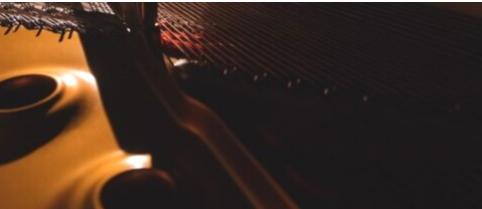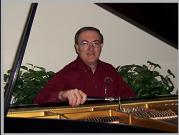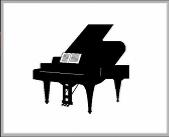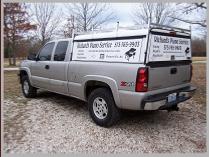Q: How often should my piano be serviced?
A: Piano strings are under a tremendous amount of tension which needs to remain constant. If the tension fluctuates too greatly, the stresses become unequal throughout the piano and can cause costly damage. Also, a piano that falls below standard pitch of A-440 will not have as bright of tone as one where the strings are at the proper tension. To minimize damage to the piano and to maximize the piano's tone quality, remember to have your piano tuned once or twice each year for moderate use and more frequently for heavy or professional use. If your piano is used for performance or recording purposes, it is common to have it tuned before each event.
Q: What time of year is best to have my piano tuned?
A: When choosing a time of year to have your piano tuned, some believe that fall and spring are the best times, being right after major seasonal changes. True, that is when the Relative Humidity is most ideal for a piano, at 43% or so. However, January and July are the best times if you want the longest period of time without major fluctuations, even though the humidity during those times are not always ideal. If your home or establishment maintains it's temperature and humidity rather well, or if your piano has a Dampp Chaser or similar humidity control system installed and functioning regularly, then this is not as much of an issue. While there is never a "perfect" time, it is always better to have it tuned than it is to wait and risk forgetting. Pitch adjustments are costly and hard on the piano! I would suggest that whatever time(s) you decide, that you stick with it.
Q: Why does my piano need a pitch-raise/lowering (sometimes called a pre-tensioning, pre-tuning, or pitch adjustment)?
A: Pianos were built to function at a certain tension and altering that can cause damage. Also, if you try to play any other instrument with the piano, you may not be able to tune the instrument to the piano, or you may have to transpose the instrumental music to be able to play in tune with the piano. Ex: trumpet, clarinet, etc.
Pitch-Raising: If your piano has not been tuned for 2-5 years or more, then there is a good chance that it has gone flat and will likely take more than one tuning before it will hold a proper tune. Over time, the tension on the piano causes much of the piano, if not all, to go flat as the tension slowly loosens with each seasonal change in humidity. It is not difficult to bring back up to proper pitch, but the trick is getting it to stay.
Pitch-lowering: The opposite of pitch-raising. This is needed when the pitch of the piano is too high. This can happen when there is very high humidity, usually in the summer months in some locations.
With both procedures, by dramatically increasing the tension in a short amount of time, the strings' tendency is to "fight" the new tension. In doing so, they will go flat a fraction of what they were just raised, or go sharp a fraction of what they were just lowered.
It also makes the piano quite unstable. Therefore, it can take several tunings before the piano re-adjusts to the correct tension enough to stay. Usually, this can be done in one extended session for general home purposes, but it often takes several more tunings before the piano will remain stable.
Here's my policy on pitch-raises:
- 8 cents flat/sharp (or less) overall - no pitch-adj. required (tune only $150)
(allow 1.5 - 2 hrs.)
- 8-25 cents flat/sharp - charged 1 pitch adj. ($40) + tune ($150) = $190
(25 cents = 1/4 semi-tone...or 1/4 the distance between two adjoining keys on the keyboard, C and C# for ex.)
(allow 2.5 hrs. to pitch raise and tune)
- 25-75 cents flat/sharp - charged 2 pitch adj. ($80) + tune ($150) = $230
(75 cents = 3/4 semi-tone...or 3/4 the distance between two adjoining keys on the keyboard, C and C# for ex.)
(allow 3 hrs. to pitch raise and tune)
- 75-125 cents flat charged 3 pitch adj. ($120) + tune ($150) = $270
(125 cents = 1 1/4 semi-tone...or 1 1/4 the distance between two adjoining keys on the keyboard, C and C# for ex.)
(allow 3.5 - 4 hrs. to pitch raise and tune)
- Over 125 cents flat charged at least 4 pitch adj. and will calculate cost based on how far it must be raised, and the additional time to do so.
I will always notify you (and show you) when a pitch-adjustment is necessary.
Q: What is Action Regulation and does my piano need it?
A: "Action Regulation" simply refers to the adjustments that a piano needs to make all the moving parts move the right way and create the best musical tone possible. The piano is a very simple, yet very technical instrument. From the key to the hammer that strikes the strings, there are levers and such that move in a very precise way to make the note play correctly. Each note on a vertical upright has 25 or more adjustments that can be made, and a grand has nearly 35. If any of these are incorrect, it will affect how the instrument performs. See grand piano action in motion here. Note all the knobs, felt, wires, screws, etc. that can be adjusted. There are also adjustments that can be made that cannot be seen, such as under and inside the key, etc.
Q: How often does my piano need regulation?
A: To maintain the right touch and prolong the life of the piano action, it is recommended to have the piano action regulated approximately every two years unless you have a humidity control system installed on your piano. As the piano is played and subjected to humidity changes, it becomes necessary to adjust its many moving parts in order for it to respond correctly. If you notice…
- notes that seem to double bounce when you play them;
- sloppy keys that are extra loose and wiggle from side to side, or are extra sluggish;
- notes that continue to ring when they should be quiet
...these are signs that your piano needs adjustment.
Q: Will I always know when my piano needs repairs?
A: Sometimes, but not always. The good news is that if you have regular tunings, I can inspect the piano to be sure that everything is working as it should be. This could prevent costly repairs in the future.
Pianos are made from a variety of materials: wood, metal, felt, plastic, and such. Although pianos are built to last, there will come a time when these materials will break down, leaving you with a sticky note, a broken string, broken pedal, broken hammer, and the list goes on. It is inevitable that repairs will need to be made. It is very important to have the repair made as soon as possible.
Continuing to use an instrument that has a broken part, or is not "acting" just right, can lead to further damage if not taken care of. Don't make things worse, get it repaired.
You (and your pocket book) will be glad you did.
Q: Where can I purchase piano covers, piano lights, and other accessories for my piano?
A: I can provide many accessory items for your piano, including such items as: piano covers, key cover locks, humidity control systems, piano lights, piano benches, and piano dollies for easy moving on stage or down school hallways. Visit my accessories page. I also have a limited selection in my piano supply catalog that I can show you when I visit.
OR, the following website has a wide selection of piano accessories as well as musically printed cups, napkins, etc.
TheMusicStand.com
Amazon.com (musically themed gifts)
PianoSupplies.com
Q: Do you tune by ear or with an electronic tuning aid?
A: Yes. Both actually. I use a SAT III (Sanderson Accutuner III) as a reference in setting the temperment, to calculate a customized stretch tuning for each piano's scale based on it's own enharmonicity, and during pitch raising. I tune all unisons by ear (which is roughly 2/3 of the piano), and on those notes tuned to the SAT III, I still make all of the necessary "checks" or musical "tests" that one would make when tuning aurally since what is heard always "trumps" what is seen on a machine. Electronic tuners nowdays are lightyears ahead of those of yester-year and can make the tuner's job much easier, so long as they don't have the final word, so to speak.
Q: What is my piano worth?
A: Good question. Basically, your piano is worth what the market will bear. Here is a website that might be helpful. http://www.pianoworld.com/value.htm
While it doesn't give prices, it does give you an idea of what might be involved in setting a price. It's always a good idea to to have your tuner/technician inspect your piano and let you know the general condition of your piano as well as if there are any concerns that need to be addressed before you sell, (or what the new owner would need to address after purchase).
This will help both parties feel good about the sale. It's not a good situation when a piano is purchased based on looks and owner opinion, only to find that the piano is going to need a substantial amount of work. One lady I know was given an old upright piano, only to find after all the hassle of moving it that it had a severely cracked pinblock and could not be tuned. Her only cosolation was that it was a gift and she fortunately hadn't paid anything for it.
In my opinion, it would be very wise, and well worth the service call, to have myself, or another qualified piano technician in your area, inspect any used piano that you were planning on purchasing....(or even receiving free of charge for that matter)....so you know what you're getting yourself into, including possible costs down the road. That "free" piano could wind up costing you hundreds more than you expected if you're not careful.
You can also get a written estimate for insurance, sale, buy, etc. for only $20 at: www.bluebookofpianos.com/
whats_it_worth.htm
Q. How old is my piano and who made it?
A. First look for the brand name, sometimes on the key cover, or most likely inside the piano printed either on the upper lid (that you set all your pictures and knick-knacks on), or somewhere on the plate near the tuning pins. Secondly, while you have the piano open, look for a serial number (typically a 5 or 6 digit number unless it's really, really, old). I've found several pianos that don't have one that I could find, but usually there will be one printed in plain view. You may need a flashlight to read it though. Write this down and close up the piano. Visit www.bluebookofpianos.com/ages/, find your brand name, and then find the year in which your serial number was made. There will also be a brief description about the manufacturer. I can also give you most of this type information free of charge when I come tune your piano if you remind me.
Q. What is the cost to have a piano tuned?
A. Costs vary greatly from one part of the country to another, and from city to rural areas. Generally you will find that on the East and West coasts, rates may average from $150-$225 per tuning. In the midwest, however, with a lower cost of living, the rates may average somewhere around $75-$150. Something to consider, though, when comparing rates is the tuner's level of experience, professional training (or lack thereof), and how much time they give you for that price. Are they full-time tuner/technicians, or is it one of several things they do for extra income? More often than not, you get what you pay for. Also, consider the distance a tuner must travel and what they may have to charge for mileage. That can add considerably to your cost, so be sure to ask before being caught off guard at the end of a tuning with a larger bill than expected! You can view my rates here.
Q. What do I need to do to get ready for the tuner's visit?
A. There are several things that you can do to prepare for my visit that will be most helpful.
1) Remember to be home at the appointed time - If you are unable to keep your tuning appointment for any reason, please call me as soon as possible. I will do the same for you.
2) Please remove all items from off the top of the piano, ie: knicknacks, pictures, piano books, etc. I would rather you handle them than me risk breaking them.
3) On vertical pianos, it is usually not necessary to move the piano out away from the wall. Tuning, and most inspections, are performed from the front of the piano. If I need to move it, I will.
4) Provide a quiet, distraction free environment. TV, radios, electric mixers, washing dishes, or kids playing in the front room, can all be very distracting when I am concentrating on listening to the slight changes in the piano's pitch and tone.
5) Please allow adequate time for me to do the job correctly.
Some tunings take longer than others, and I always want to do the best job for you, so it would be helpful to avoid planning somewhere to be immediately after the tuning in case we go longer than expected. I usually estimate 2 hrs. for a regular tuning. If the piano needs a pitch raise (pre-tensioning), then allow another hour or more for that. Don't forget that if we find a repair or adjustment that needs to be made, that can add time too. So...bottom line, do allow enough time for me to leave your instrument in great shape without feeling rushed!
6) A piano bench would be nice! I say that in fun, but I have showed up at homes only to find that there was no piano bench. If you don't have a piano bench, an armless chair of about 18"-19" will work.












